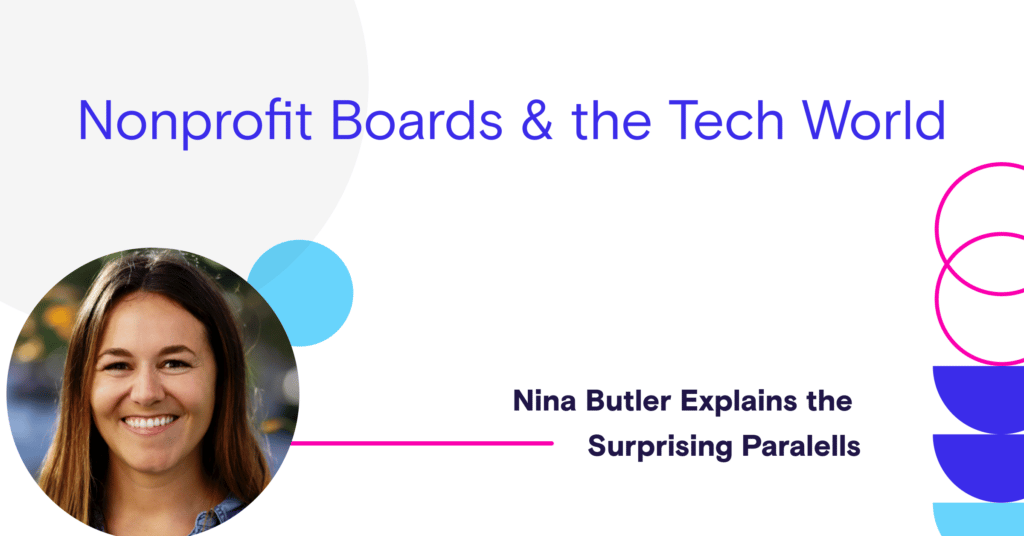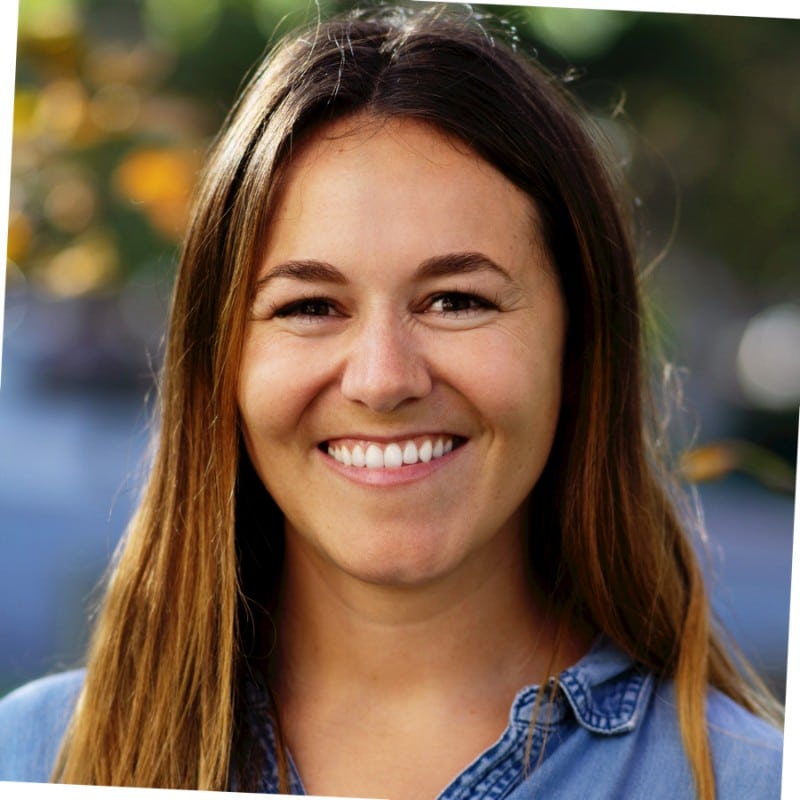
Nina Butler is uniquely qualified to identify the similarities between the B2B SaaS world and nonprofits. She explains what works in both areas.
For Nina Butler, life is all about connection. Born on Martha’s Vineyard in a picturesque, close-knit town, today she’s forging community relationships via storytelling as a board member of the nonprofit Everyday Boston.
But the most surprising connections lie between her 9-to-5 job as the Senior Director of Revenue Marketing at Alyce and her “5-to-9” role as a board member.
At first glance, B2B SaaS and nonprofit work have nothing in common, which led Nina to feel an initial sense of imposter syndrome when she was approached for the role. In reality, her duties couldn’t be more similar.
Here, Nina explains the concrete correlations between the two worlds when it comes to:
- Marketing strategy
- Revenue modeling
- Business development
- Hiring tactics
1. Marketing Strategy Parallels
Everyday Boston marks Nina’s first foray into the world of nonprofit board duties. Prior to joining in 2017, she had advised a couple of tech companies but considered herself a nonprofit novice.
That’s why she was skeptical when Cara Solomon, her friend and Everyday Boston’s founder, asked her to join.
“I remember asking, ‘Are you sure you want me?’ Then when we talked about what she was hoping I’d be able to bring to the table, I said, ‘Oh. This is what I do every day,’” Nina says.
Go to Market
The first parallel Nina identified was the idea of taking a product or service to market.
In the SaaS world, you activate your offering with a go-to-market strategy. In the nonprofit world, you activate your offering with your programming.
For both SaaS and nonprofits, the goal is to get visibility for your offering to build up a strong customer base and a good reputation. Ultimately, a SaaS company hopes to increase revenue, while a nonprofit aims to increase funding.
“It’s all about getting eyeballs on the program that you’re building, so you become eligible to receive more grant funding or you become more enticing to get sustained donorship,” Nina says.
As the board’s marketing guru, Nina’s job is to think about things like:
- What is the competitive landscape?
- Who are the groups we want to partner with?
- What channels do we want to market on?
- How do we message appropriately?
The terminology may vary between the SaaS and nonprofit worlds–e.g. go-to-market strategy versus programming–but the end goals are the same.
Engage Your Audience
Once you think through various go-to-market factors, you’ll begin to get a firm grasp on your organization’s target audiences and the best channels to reach them. Next, you need to determine how to market to those groups effectively.
Everyday Boston’s mission is to break down stereotypes and increase connections by surfacing the stories of real Bostonians. Nina considers what storyline is going to resonate best with groups like program participants and corporate workshop clients. The aim is similar to her B2B SaaS goals.
“How do you craft a newsletter that will have a high open rate and high engagement? How do you create a social campaign that will 2x your following? It’s about trying to get more exposure,” Nina says.
When you create a story that resonates with the right audiences in the right ways, you set yourself up for more visibility and more momentum.
For Everyday Boston, more publicity can result in valuable co-marketing and partnership opportunities that drive the organization forward.
Optimize for Growth
Partners are to the nonprofit world what customers are to the for-profit world.
In a tech setting, customers are the key to growth, and all activities center around optimizing for website transactions.
But for a nonprofit like Everyday Boston, there’s more to growth optimization than securing partners. It’s also about growing the entire nonprofit “engine” as a whole.
“How do you increase not just your donor base, but get more people to be part of the entire engine? The more stories you capture, the more you have to say, and the more people take notice,” Nina says.
At Everyday Boston, Nina thinks differently about the audience she is marketing to and the behaviors she wants to drive. Instead of only optimizing for donor “transactions,” she is also optimizing for getting more community participation.
While all these marketing skills don’t seem transferable on paper, Nina has found they are remarkably transferable in practice.
2. Revenue Modeling Parallels
The second parallel Nina identified is that tech companies and nonprofits rely on clear revenue models and recurring revenue sources.
Secure Predictable Revenue
In the for-profit world, companies want to increase revenue as much as possible. In the nonprofit world, organizations just need to bring in more money than they spend.
In both worlds, a healthy revenue flow is a predictable one.
“For Everyday Boston, predictability comes down to knowing about the grants we will be eligible for on an annual basis and the private contributions we can rely upon,” Nina says.
The primary objective is to secure repeatable funding sources on a week-to-week and month-to-month cadence.
Pursue Operational Efficiency
To increase profit, SaaS companies don’t just focus on securing repeatable business. They also strive to improve operational efficiencies and lower the cost of customer acquisition.
Many nonprofits do not have the operational mindset that tech companies do—but they would benefit from developing one.
“Nonprofit leaders are sometimes over-indexed in the ability to tell a great story and evoke emotion in people. It’s helpful to think about how you can bring more of an operational lens to a nonprofit,” Nina says.
While a passionate founder is exactly what a nonprofit needs, board members who add a for-profit mindset can help take a nonprofit from an inspiring vision to a thriving reality.
Watch this video to learn how the Maryland Farm Bureau used OnBoard to streamline board assignments and increase operational efficiency.
3. Business Development Parallels
Leveraging business development tactics is another area where nonprofits and tech companies overlap on a figurative Venn diagram.
Currently, funding for Everyday Boston is equally split among individual donors, grants, and corporate workshops. While the nonprofit doesn’t have a formal business development function, it does want to find better ways to package and systematize programs like its former inmate Bridge Program and corporate workshops.
Create Content that Scales
To help operationalize Everyday Boston’s programs, Nina’s goal is to create content that is transferable and scalable.
For example, former inmates in their Bridge Program might benefit from a “Welcome Home” playbook, while corporate workshop seminars can be run more effectively with reusable educational content.
Scalable content serves a threefold purpose: First, quality content benefits the program participants served. Second, it saves nonprofit team staff time and energy as they no longer have to reinvent the wheel. Finally, scalable content helps to further market the nonprofit’s mission and value.
In the case of Everyday Boston, the ultimate goal is to find ways to message, price, and position offerings to win new “business”—such as recurring donations or corporate workshop clients—from eligible companies.
Secure Internal Buy-In
Just like corporations, nonprofits need to first secure internal buy-in so they can successfully win external support.
Nina gave the following example to demonstrate the importance of building your internal business case:
“Say we’re cooking up an Account-Based Marketing event at Alyce, and I would like sales’ partnership to make sure the invites are personalized. I have to build the business case and sell why it matters. And you have to do the exact same thing within Everyday Boston.”
Once Nina crafts compelling messaging for Everyday Boston’s corporate workshops, she next needs to enlist her colleagues within the organization to create a united front and move forward with prospecting activities.
If the B2B SaaS world is quintessentially relationship-motivated, the nonprofit world relies on relationships tenfold.
Download OnBoard’s 2022 Board Effectiveness Survey to learn more about how surveyed board members view effectiveness and work to achieve it.
What Changed for Boards in 2022?
4. Hiring Parallels
When it’s time to secure new board members, a nonprofit uses the same recruitment techniques as tech companies.
Fill Expertise Gaps
While Nina’s expertise lies in marketing, her fellow board members excel in areas like nonprofit fundraising, legal compliance, financials, and operations.
“I’m the first one to admit I don’t know how to fill out a grant application, but that’s not the purpose I serve. It goes back to having a clear definition on the board in terms of who owns what,” Nina says.
The right person to join the board is the person who adds value and fills a void in board expertise.
Find People Who Bring Your Mission to Life
Once you know what expertise gaps you need to fill on your board, it’s time to put out feelers for the right person. The best candidates will be those who share the organization’s values and live and breathe its mission.
The right people for the job might also be outside your immediate network. For example, Everyday Boston has an advisory board that is separate from the executive board. When they want to add to the advisory board, they look to varied sectors like the Boston public school system, the local government, and pockets of the city that are hyper-connected to the community.
“Our goal is to stay true to the roots and the mission statement of Everyday Boston,” Nina says. “It comes down to understanding who has the closest degree of separation from somebody that we’d like to invite into our fold.”
Read more about the role of nonprofit advisory boards.
Diversify
Besides seeking participants who represent a variety of networks, professions, and skills, it’s important to seek out members who will add diverse perspectives.
“We have representation from old and young. We have representation from at least four different neighborhoods in Boston and counting. We have different representation racially, religiously, and in terms of overall experiences,” Nina says.
In fact, one of Everyday Boston’s most valued board members was incarcerated several times —and was just nominated for an Academy Award for an original screenplay.
Nonprofits and for-profits alike benefit from inclusive practices. Whether it’s a new member of the executive board or a part-time program leader, double-check your instincts on who is “right” for the role, and look for valuable connections that go deeper than surface level.
Find Fulfillment Where Tech and Nonprofit Intersect
Whether it’s your day job or nonprofit board work, your level of investment determines the reward you reap.
“Much like a corporate job, I’m learning so much at Everyday Boston,” Nina says. “There’s been almost no turnover on our board because people feel as though they’re getting as much out—if not more—than they put in.”
At the end of each day, Nina feels proud and fortunate that she gets to live and engage in her Boston community and create new connections through her nonprofit work.
“It’s only going to feel good if I continue to familiarize myself with my neighbors, both literally and figuratively. If I can help amplify Everyday Boston’s message in my small pocket of the world, that is really exciting. That is the best use of my 9-to-5 skills,” Nina says.
OnBoard was designed to transform board meetings for the better—and forge more efficient, connected nonprofits in the process. Request a demo today.
Want to fuel your startup for success? Get started with a free trial of OnBoard.
About The Author

- Jillian Walker
- Jillian Walker is a customer success manager who specializes in helping nonprofit organizations get the most from their board meetings. She's also the founder of the Indianapolis-based non-profit TraceIndy, which is dedicated to connecting professional women across communities
Latest entries
 Board Management SoftwareOctober 31, 2022How to Start a Nonprofit in Ohio (Step-by-Step Guide)
Board Management SoftwareOctober 31, 2022How to Start a Nonprofit in Ohio (Step-by-Step Guide) Board Management SoftwareOctober 24, 2022How to Start a Nonprofit in Georgia (Step-by-Step Guide)
Board Management SoftwareOctober 24, 2022How to Start a Nonprofit in Georgia (Step-by-Step Guide) Board Management SoftwareOctober 11, 2022How to Start a Nonprofit in North Carolina (Step-by-Step Guide)
Board Management SoftwareOctober 11, 2022How to Start a Nonprofit in North Carolina (Step-by-Step Guide) Board Management SoftwareOctober 5, 2022How to Start a Nonprofit in California (Step-by-Step Guide)
Board Management SoftwareOctober 5, 2022How to Start a Nonprofit in California (Step-by-Step Guide)

